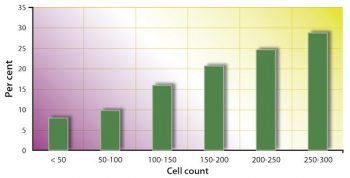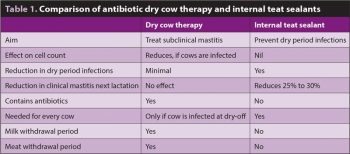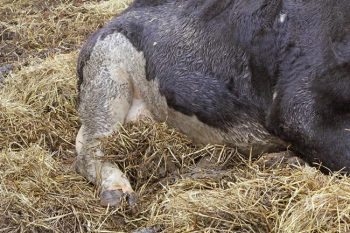20 Feb 2017
Peter Edmondson discusses why vets are best placed to help farmers make the transition to selective dry cow therapy.

Image from “Selective dry cow therapy – engaging farmers in the process” by Peter Edmondson.
Farmers have a lot on their plate at present – low profitability, uncertainty about Brexit, never-ending paperwork and so on. You can understand, therefore, when we mention selective dry cow therapy (SDCT), they are unlikely to jump with joy at the prospect of changing, even if they think it is a good idea.
Almost all farmers and vets think it is a good idea, but they don’t really want to start the process now. This article intends to help with farmer engagement on this topic.
Farmers listen to us and sometimes take our advice, but they listen with far more interest to other farmers. One of the best ways to engage them is to have a small group of farmers come in for a lunchtime or evening meeting – with food and drink as a good attraction. Take them away from the farm, so you have their attention without distraction. Have a chatty farmer, who is a SDCT convert present, and he will be the one likely to persuade others to change. You become the meeting coordinator and direct it to ensure the key points you are trying to get across are covered.
When we are attempting to convey a message about something such as SDCT, we really need to think through how this is approached and communicated. What are the key points you are trying to get across? How will you do this? Are there practical aids you can use to help explain these concepts? What will farmers hear? How will they respond? How will you deal with the objections raised?
Here are two examples of how to approach difficult issues such as SDCT:
So what happens in real life? With option 1, all the items raised are negative and worrying – people are immediately in a “rejection” frame of mind. It is unlikely they will buy in to SDCT and you could put some off for life. When you ask them for the positives, they are so negative they can’t really think of any, as many of them have already decided it is not going to work and is far too complicated.
Option 2 is very different. People come up with all the benefits and you will be surprised how many they can find. Then, when they are asked about their worries or things that have to be overcome, they are already in a positive state of mind, so their attitude to any problem changes. I remember running through this second option, and when I asked for any worries or concerns, one farmer said there were so many positives, he found it difficult to think of anything negative.
This highlights the different ways we can approach any topic. Of course, many farmers will be very sceptical about SDCT and our job is to help them overcome this. We have to be convinced about the benefits, so doing this exercise in the practice first – so the whole team buys in – is essential. There is nothing more undermining than having one person in the practice who disagrees with the rest of the team and is vocal about this – it raises doubt and does little for the practice’s image.
SDCT is a new concept for many dairy farmers. Sure, they might have read about it in the press or at some meeting, but our role as vets it to help them make this transition without problems. Over the past year I have asked different veterinary audiences if they think SDCT is the right thing to do and all, bar a couple of dissenters, agree. When asked if it will be positive for cows, the answer is the same – yes, and potential issues can be overcome.
Planning the communication strategy is key and you can break down topics into several headings, such as:

The introduction might include a bit on dry cow therapy, what it is and why blanket use was recommended. Antibiotic dry cow therapy was recommended by the National Institute for Research into Dairying when devising its Five Point Plan to tackle high cell counts in the late 1960s. Blanket use was recommended, as the majority of cows had subclinical mastitis and the prevalence of Staphylococcus aureus and Streptococcus agalactiae was very high. No individual cow cell count testing was available. For this reason, blanket use was advised and became the norm for the majority of herds.
SDCT has been the only form of dry cow therapy in Denmark – blanket use has never been allowed. So, while it’s new to us, it’s not new to farmers in some countries and that is reassuring to many farmers. Some organic farmers moved to SDCT years ago to reduce antibiotic use (Figure 1).
Antibiotic dry cow therapy is used to help eliminate subclinical infection at the end of lactation. This has always been its key aim and it has also been used to help prevent new infections, but its effect here is quite small.
Remember, the majority of cows are free from subclinical mastitis at dry-off. National Milk Records data (2016; personal communication) showed only 20% of cows had subclinical mastitis in herds with cell counts of 200 or less. In lower cell count herds, this proportion was even less (Figure 2).
Internal teat sealants were introduced into the UK in 2004 to help prevent new environmental infections during the dry period – in particular, Escherichia coli and Streptococcus uberis. A mass of research has shown using an internal teat sealant will reduce clinical mastitis by 25% to 30% in the following lactation. For those herds with a high prevalence of dry period infections, an even greater reduction exists in clinical mastitis.

In effect, two separate products are available – dry cow therapy to help eliminate existing infections and an internal teat sealant to help prevent dry period infections (Table 1). Every cow is at risk of dry period infection, so will benefit from an internal teat sealant.
Dry cow therapy should only be used for cows with known infections at dry-off, which will be cows with elevated cell counts or those that have had a case of clinical mastitis during lactation. The reason cows with clinical mastitis receive antibiotic dry cow is because some cases have low bacteriological cure rates. For example, S uberis or S aureus bacteriological cure rates can vary from as low as 5% to around 80%. These clinical cases get antibiotics at dry-off unless evidence shows they are not necessary – for example, low cell counts following treatment indicating infection has been eliminated.
SDCT has many benefits. Ask your clients to list them, as they will take more ownership of these compared to you explaining them. You can add in or suggest any of the benefits missed. The benefits of SDCT include the following.
Farmers are responsible individuals and will know reducing antibiotic use is the correct thing to do as they are producing a quality food product. This will help protect their market share and the health of consumers – as well as their families.
Reduce the risk of bulk tank antibiotic failure by reducing the amount of antibiotic dry cow therapy used. Human error, or something going wrong, is always a risk whenever a cow is treated and dry cow products can have long milk withdrawal periods. The cost of bulk tank failures is considerable to farmers as well as milk buyers.

Farms will use mastitis data to select cows that can receive antibiotics at dry-off. This data should be used to help establish levels of clinical mastitis and can help identify the source of infection, lactating or dry period infections, and whether the problems are due to contagious and/or environmental bacteria (Figure 3). Cows for culling will also be identified. Too often, little use is made from mastitis records.
With SDCT, any cow that does not receive antibiotics at dry-off must receive an internal teat sealant to prevent infection occurring during the dry period. This would be a minimum, but it is recommended all cows benefit from receiving an internal teat sealant at dry-off as a high risk of dry period infections exists.
More than 50% of cows in the UK receive a teat sealant at dry-off. Increasing the use of internal teat sealants has advantages in that it:
It is essential staff who are administering an internal teat sealant – either on its own or in conjunction with antibiotic dry cow therapy – are fully trained. This should involve on-farm training at the time of dry-off. It is essential everyone understands the correct procedures to minimise the risk of introducing infection and follows these every time a cow receives any intramammary treatment. This should be explained, demonstrated and then have staff demonstrate it back to the trainer.
Occasionally, cows calve early due to errors with records or if the herd does not carry out pregnancy diagnosis. Milk from cows that calve early and treated with antibiotic dry cow therapy has to be discarded for the full withdrawal period – even if the animal is milked. However, there are no problems having to withhold the milk if a cow calves early and has only received an internal teat sealant. A zero withdrawal period exists on the use of internal teat sealants.
The risk of introducing infection at dry-off is reduced if you are only administering one tube compared to two, such as if the herd is using dry cow therapy and a teat sealant. The fewer times you have to infuse any tube, the better, as you reduce the risk of introducing infection on the nozzle of the syringe. The time-saving element will also be welcomed.
Some data shows an increased risk of E coli mastitis when low cell count cows are treated with antibiotic dry cow therapy.
There must be benefits from reducing traces of antibiotics fed to baby calves. Any antibiotics are likely to change the bacterial flora in the gut, which cannot have a positive effect on calf health.
Herd A is a 200-cow herd that uses antibiotic dry cow therapy and internal teat sealants, and has a 25% replacement rate. This means 150 cows will be dried off. If you are able to reduce antibiotic dry cow therapy use by, say, 50%, this results in a significant cost saving. The saving is £450 – assuming antibiotic dry cow tubes cost £6 per cow. This might not sound much, but it will pay for bovine viral diarrhoea or leptospirosis vaccinations for the milking herd. This is a good substitution of costs.
Herd B has 200 cows that have only been using antibiotic dry cow therapy. The saving of £450 will be offset by an increase in the use of internal teat sealants in cows, but they do not receive antibiotics. For this herd, no overall savings in dry cow treatments are made. However, this herd will benefit through reduced clinical mastitis from use of teat sealants. This is where thereal saving comes.
Herd B had 40 cases of mastitis per 100 cows in the year before moving to SDCT. The owner estimates each clinical case costs £200. The 75 cows that did not receive antibiotic dry cow therapy would have had 30 clinical mastitis cases. The use of an internal teat seal will reduce the cases by at least seven. So, while no saving is made on the costs of intramammary tubes at dry-off, the real saving for this farmer will be seven fewer cases of mastitis worth £1,400, plus less work associated with managing each clinical case. Everyone here is a winner. If the farmer were to use blanket internal teat sealants, the cost benefit would be even greater.
Consider the effort and work that goes into any company’s sales or marketing campaign – meticulous planning, preparation and clarity of messages are involved. If we take the same approach when talking about SDCT, there is no reason why we can’t be just as successful in introducing and implementing this concept.